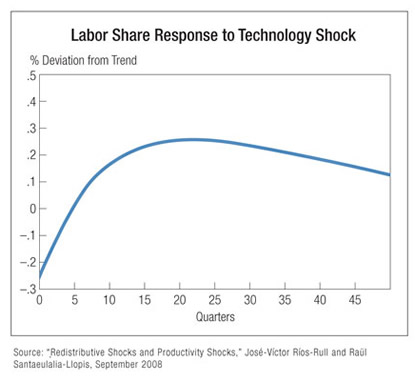Well aware of the advantages of specialization, and undoubtedly predisposed by talent and taste, many economists brand themselves early on as monetary theorists, international economists, industrial organization economists and the like.
José-Víctor Ríos-Rull, on the other hand, is a hard guy to peg. His research has uncommon scope, ranging from credit cycles to housing markets to inflation targets to fertility decisions. He’s produced influential papers on pure theory and others that are entirely data analysis.
True to his University of Minnesota Ph.D. roots, though, most of Ríos’ work blends theory and data with meticulous empirical evaluation of economic hypotheses. As he puts it, one of his fortes is “putting nasty, complicated environments into a computer”—that is, structuring databases and designing mathematical models to accurately reflect and analyze complex socioeconomic phenomena. And that skill is evident in much of his research.
Ríos, a professor at the University of Minnesota, agrees that he covers a lot of ground. “Maybe too much,” he jokes. But he demurs that he’s not unusual in this respect. “Look around here,” gesturing toward his Minneapolis Fed colleagues, “and you’ll see people do many things. That’s a very valuable part of economics.” But the fact is, very, very few economists delve into so many disparate areas with such insight and skill.
A full review of Ríos’ far-reaching scholarship is beyond the scope of this article, but a quick look at another area of recent research (in addition to the accompanying review of his forthcoming study on the living arrangements of widows) might give a sense of his breadth of interest and depth of research.
Labor share
In economics, where much is uncertain, one seeming constant has long been “labor share,” the portion of national income earned by workers. As a rule of thumb, economists put the figure at two-thirds for the United States, meaning that laborers earn that portion of the economic pie and owners of capital get the rest. According to a 2004 St. Louis Fed paper, this allocation “is considered one of the more remarkably stable relationships in the U.S economy.”
As it turns out, the relationship may well be solid, but it is far from constant. In a 2008 paper with Raül Santaeulàlia-Llopis of Washington University, Ríos looks carefully at the data and finds that during a 50-year period, from 1954 to 2004, U.S. labor share was quite volatile. And one feature of that volatility is particularly puzzling: “Labor share,” they observe, “overshoots.”
After a technology shock, labor share has an immediate but brief downward response, dropping by more than 0.2 percent. It then begins a steady rise, and a year and a half (six quarters) after the initial shock, labor share climbs above its long-term average. The rise continues for about five years (20 quarters), peaks at 0.27 percent above average and then declines very slowly toward its long-run trend (see chart).

The first part—the immediate drop of labor share in response to a technology shock—was not a surprise, says Ríos. “Most people knew that it goes down a little bit.” But the overshooting was completely unexpected. “That’s the key thing. Nobody had noticed that it moved that way; nobody had noticed that it slowly climbs up and overshoots.”
And standard economic models can’t explain that overshooting, since they assume that labor share is constant. As he and Santaeulàlia-Llopis write, “Our results drastically change the assessment of previous findings … and point to the urgent need to understand the joint cyclical behavior of factor shares and productivity.”
Generating overshoot
So in a subsequent paper with Sekyu Choi of the University of Pennsylvania, Ríos looks more deeply into the dynamics of labor share. By breaking down the labor share response into changes in wages, hours per worker and employment, they find that the latter is what responds most to technology innovation. The overshooting, they write, “is due to the hump-shaped response of employment during an expansion. Hours per worker and wages have weaker responses.”
Understanding why employment is so responsive requires a mathematical model that resembles the economy and generates the overshoot. Choi and Ríos try to build it. Two assumptions, they note, underlie the models that have constant labor share: competitive factor pricing and a Cobb-Douglas production function. In their paper they focus on the first assumption—that labor markets are competitive—and see if dropping it can give them the response found in the data.
The model they build has labor markets where the effort expended in finding a suitable job (or employee) prevents “the seamless allocation” of workers to jobs, and where bargaining between workers and employers introduces a measure of wage rigidity. Job search and Nash bargaining are standard devices in the toolbox of economists, means of introducing real world frictions to the ideal dream of perfectly competitive economies.
Unfortunately, the model doesn’t work. It churns out the initial sharp drop in labor share, but it never overshoots (see “baseline model” curve in chart below). “We thought it had the potential of generating some interesting dynamics,” Ríos recalls. “It turns out that it doesn’t. The deviation from competition is very short and after a period or two goes back to its long-term average.”
They try a couple of variations. Neither works. “There was nothing there,” says Ríos. “Which tells you two things: Either noncompetitive factors are not so important, or we’re thinking of them poorly. I think we can learn a lot from failure, but what we don’t learn much from is ambiguity. When it depends on interpretation, then we don’t learn a lot.”
Promising failure
Still, Ríos isn’t entirely discouraged. If dropping the first assumption behind standard models can’t generate a good fit to the data, then perhaps the second assumption—the Cobb-Douglas production function—is expendable. With Choi he briefly explores that avenue (by altering the elasticity of substitution between capital and labor from the 1 built into the Cobb-Douglas standard to 0.75).
The results are “promising,” they write, and indeed, the model with this altered production function generates a bit of a hump resembling the labor share overshoot seen in the data (see red line in chart below). “We take this as evidence that exploring different [production function] technologies might be a good direction for further research,” they conclude.

Ríos is philosophical about the research. “We thought of this paper as an interim report on failures,” he says. It doesn’t have the dramatic positive finding that scientists hope to announce, but it does eliminate several options and opens other possibilities. And there’s little doubt that, over time, Ríos will explore many of them.
—Douglas Clement
Return to: Mother and Child Reunion




